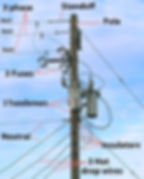
AEC has a bright future, but it must be built and will not happen by accident. Your AEC Board sets the vision for the Cooperative, which is why it is important to have people with leadership talent and technical understanding on the Board. Vision is a picture of the future, and it must be effectively created and communicated by leadership to all stakeholders, from management, operations, and maintenance to the members. The vision must be bold and stretch our capabilities, personally and professionally, giving us something bigger than ourselves to participate in and influence.
Yes, there are issues and problems at AEC that must be addressed, but these are fixable IF we pull together and simply do it. But we can go further and achieve more than just fixing the obvious. Vision is the key, so leadership must provide it. Business as usual will not get us there with the new population growth numbers for Jefferson County. The Board must lead AEC to build an operational culture to creatively use Continuous Improvement (small, achievable results every day) to move toward the vision: Safe, reliable, and efficient power delivery to all AEC members.
Building AEC’s Future
ABOUT BUDDY LEE
WHAT TO KNOW
Buddy holds four degrees: A Bachelor of Music (CNC, 1982); a Bachelor of Science in Electrical Engineering (UTK 1987); a Master of Business Administration MBA, (UTK, 2013); and a Master of Science Degree in Reliability Engineering Statistics (UTK, 2021). Buddy also completed the coursework for a Doctor of Business Administration (DBA) at Lincoln Memorial University (2023).
CERTIFICATIONS
Buddy’s early career was in industrial vibration monitoring, and he is a co-holder of US Patent #6,276,213 “Signal Conditioner for a Vibration Sensor.” He was an instructor at Emerson prior to joining Mesa Associates, where he uses Digital Transformation and Machine Learning applications to optimize power generation and manufacturing processes.
CAREER ACCOMPLISHMENTS
AEC currently serves over 50,000 members. Each member is a partial owner in the Cooperative, and District 8 has close to 5,000 members, or approximately 10% of the total population of members. Refer to the map of District 8 in the picture, and you can see the geographical area covered. Basically, anything south of Highway 139 and then Highway 25/70 to include most of Downtown Dandridge, Paradise Cove, Shady Grove, Terry point, most of Muddy Creek, The Point Restaurant and Marina, Highway 92 back towards Chestnut Hill, Sugar Forks, Rimmer and Koontz Creek, Douglas Estates, Indian Creek, Swan’s Marina, Swansylvania, Oak Grove, Flat Woods, and Baneberry including Taylor Bend.
Facts About AEC and District 8
%202_001.png)
Parts of a Telephone Pole, your Electric Meter and Money
If you have never considered all the pieces of equipment required to bring you power to your home, just think about the closest thing to your house: your local telephone pole and meter.
Residential transformer voltage in the United States commonly has high voltage 7,200 Volts or 14,400 Volts before being transformed to the low voltage 240/120 Volts for your house. Most residential service is single phase, 110-120 volts, with 220 volts for dryers, stoves, and some air conditioning circuits.
On the pole at the top are the high-voltage hot wires, generally connected by stand-offs and ceramic insulators. Then a wire connects to the fuse (switch), another set of ceramic insulators, and then the can-type transformer, which steps the voltage down to the final 110/220 volts going to your house on the drop wires, which connect to the weather head pole and down to your main panel.
Your power meter (the spinning thing located just above your main breaker or fuse panel) is where the usage data for your electricity consumption is recorded. The meter measures the amount of electricity used in watts, or really kilowatt hours (a Kilo = 1,000).
A watt is the product of the voltage and amperage (current) in an electrical circuit: 1 volt x 1 ampere = 1 watt. But this formula only represents the measure of electric power. To measure actual energy usage, time must be included. Therefore, electrical usage is a measurement of watts used over time. Since 1 kilowatt hour = 1,000 watt-hours, if you turn on a 100-watt light bulb for 10 hours, the energy usage is calculated as 100 watts x 10 = 1,000 watts (or 1 kilowatt hour). That is the part you are charged for!
If this information is interesting to you, please have a look at the Blog section of this website for more information. You can clearly see that it takes a lot of equipment to bring electric power to your house. AEC exists to accomplish that task safely, reliably, and effectively. This task is neither simple or trivial, but we take electricity for granted, until it is not there!
_jfif.jpg)